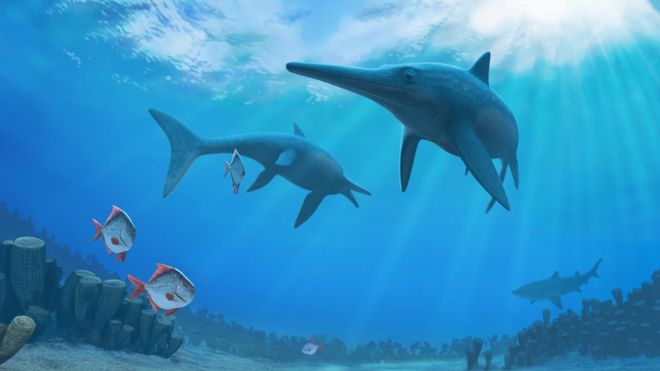A dramatic shift in the Earth’s climate killed off marine reptiles that swam at the time of the dinosaurs, according to a new study.
About 100 million years ago, the oceans warmed up, polar ice melted and sea levels rose to unprecedented heights.
Scientists say the ichthyosaurs, or “fish lizards”, could not adapt to the new conditions, spelling their demise.
The research is the latest twist in the mystery of how and why the predators disappeared.
Evidence suggests their extinction about 100 million years ago was driven by intense climate change and their inability to adapt to the changing world.
“Our results support a growing body of evidence revealing that rising sea levels and sea temperatures profoundly reorganised marine ecosystems about 100 million years ago,” said lead researcher Dr Valentin Fischer of the University of Liège, Belgium, and the University of Oxford, UK.
“The ichthyosaurs were unable to adapt. They were evolving very slowly during the last 50 million years of their reign.
“When the environment changed very rapidly they couldn’t keep up with this change.”
Family tree
During the age of the dinosaurs, the ocean was home to many types of ichthyosaur.
The marine predators evolved a streamlined body like a dolphin and were built for speed, feeding on fish and squid.
Ichthyosaurs endured for millions of years. They appeared in the Triassic, reached their peak in the Jurassic, then disappeared in the Cretaceous – several million years before the last dinosaurs died out.
Past explanations for their disappearance have focussed on their food supply, which may have dwindled as other marine animals such as sharks and bony fishes appeared.
The researchers – from the UK, Belgium, France and Russia – think this was just one factor in the animal’s demise.
After drawing up a detailed family tree of the evolution of ichthyosaurs and analysing the causes of their extinction, they believe many factors were to blame.
“Although the rising temperatures and sea levels evidenced in rock records throughout the world may not directly have affected ichthyosaurs, related factors such as changes in food availability, migratory routes, competitors and birthing places are all potential drivers, probably occurring in conjunction to drive ichthyosaurs to extinction,” Dr Fischer added.
‘Super greenhouse world’
Dr David Martill of the University of Portsmouth, who was not involved with the study, said the move to a “super greenhouse world” would have had a huge impact on the habitats of animals on land and in the sea.
Ichthyosaurs shared the ocean with other great groups of large marine reptiles such as the plesiosaurs and mosasaurs, however, which managed to outlive them.
“They [the ichthyosaurs] just disappear while a lot of animals living alongside did alright,” Dr Martill told BBC News.
“Some mysterious thing was involved. I think it’s still an enigma.”
The famous fossil hunter Mary Anning discovered the first complete fossil of an ichthyosaur in the cliffs near Lyme Regis, Dorset, in 1810.
Her discovery shook up the scientific world and provided evidence for new ideas about the history of the Earth.
Source: BBC News

































Leave a Comment
You must be logged in to post a comment.